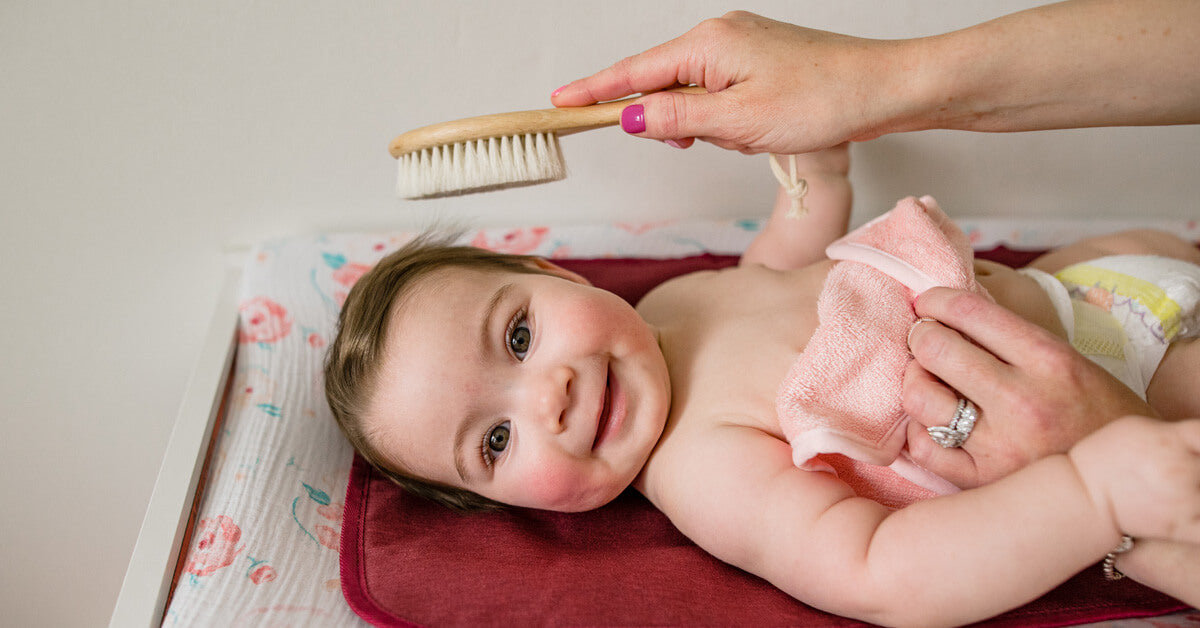
Our Favorite Products For Dealing With Cradle Cap
Is your newborn’s scalp suddenly dry and flaky, or yellow and greasy? If so, your baby is likely suffering from cradle cap - a very common (and treatable) condition in infants. Read on to discover our best tips and tricks for dealing with this pesky newborn skin condition!
Your baby is a few weeks old, and all of a sudden, pesky little white flakes start showing up all over her head (and maybe even other parts of her body). What is this dandruff-like condition, and what is the best way to get your sweet little one’s hair soft and kissable again?
If your baby’s scalp has suddenly become dry and flaky, here’s the good news: it’s a very common, harmless condition called infantile seborrheic dermatitis - commonly referred to as “cradle cap.” Cradle cap basically refers to dandruff that appears on infants. And although it’s rather unsightly, cradle cap doesn’t seem to bother infants at all, and it usually clears up within a matter of months. It doesn’t usually cause itching or pain.

Although adults experience dry, flaky dandruff on their scalp, babies can experience cradle cap on other parts of their delicate skin, such as the neck, eyebrows, nose, ears, eyelids, belly, and legs.
Cradle cap often appears as dry, white scaly flakes, but it can also be yellow-tinged and greasy, or red and patchy. Your pediatrician can diagnose cradle cap and distinguish it from other skin conditions such as eczema that may cause similar-looking dry patches. While cradle cap doesn’t require medical treatment, babies that have eczema might need a prescription cream to clear up any itchy, painful rashes.
How long will the cradle cap last?
Some experts hypothesize that cradle cap often occurs in the first few weeks or months of life because mothers pass some of their pregnancy hormones onto their babies before birth, causing an overproduction of oil in the oil glands and hair follicles in their infants. Cradle cap usually appears a few weeks after birth and can last until 12 months of age. However, most cases tend to clear up well before your child’s first birthday.
So, if your baby struggles with cradle cap, take a deep breath and remember it probably bothers you a lot more than it bothers your little one! Cradle cap can be a pain to deal with, and although it doesn’t require medical treatment, there are several amazing products on the market that can help restore your baby’s scalp to soft perfection in no time!
Take a look at our list of tried-and-true cradle cap remedies, featuring our very own KeaBabies products!
-
Washing your baby’s hair more frequently. This might help prevent a buildup of oils on the scalp and stop greasy patches from forming. Some parents wash their child’s hair every day.
-
Using a mild baby shampoo. Parents should avoid using soaps and shampoos with harsh scents and chemicals. Babies have very delicate skin, and a cradle cap flare-up might be a reaction to certain products that are too harsh for your infant’s sensitive scalp.
-
Using a cradle cap shampoo. If switching to a mild shampoo doesn’t do the trick, try switching to a medicated shampoo made to treat cradle cap. You can ask your child’s pediatrician to recommend a certain brand to use on your child. Mustela, Bella B Naturals, Cetaphil, Dr. Eddie’s, and Hip Peas all make cradle cap shampoos that are safe for babies and toddlers.
-
Using a special comb and brush. There are certain combs and brushes made to treat cradle cap. Some brushes are too prickly and sharp for your baby’s soft skin, so using a soft-bristle brush can make a huge difference! The KeaBabies Baby Wooden Comb and Brush Set come with three natural, soft brushes to tame your baby’s scalp without damaging the hair follicles. The brush with premium bamboo bristles helps support the scalp by increasing blood circulation, while the soft bristle brush made from goat hair is great for gently scrubbing your baby’s head. The soft, smooth pearwood comb can help keep your baby’s hair nice and neat without tugging on the strands.
-
Gently massaging your baby’s scalp. Gentle massage can be a great way to treat cradle cap. Parents should refrain from scrubbing and scratching at their baby’s scalp, as this can make the condition worsen. If you have the KeaBabies Baby Wooden Comb and Brush Set, use the non-invasive goat bristle brush to carefully brush your baby’s scalp, and then use the soft bamboo bristles to gently massage the scalp. You can also massage oil (such as coconut oil) into your baby’s scalp as a pre-treatment before bathtime. This can help loosen the flakes and make them easier to comb out after bathtime.
Cradle cap is common - but treatable! If your baby is struggling with dry, flaky skin on her head, try using some of the methods described above to help treat the condition at home. Within a matter of months, your baby’s hair and scalp should be back to normal!
Do remember to follow us on Instagram @keababies and join our loving and supportive KeaCommunity Facebook Group!
Parenting is awesome. Sleep is overrated. Every day is an adventure.
|
|
Meet Our KeaMommy Contributor: Kaitlyn Torrez I’m Kaitlyn Torrez, from the San Francisco Bay Area. I live with my husband and two children, Roman and Logan. I’m a former preschool teacher, currently enjoying being a stay at home mom. I love all things writing, coffee, and chocolate. In my free time, I enjoy reading, blogging, and working out. |


























































